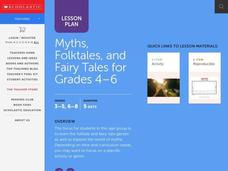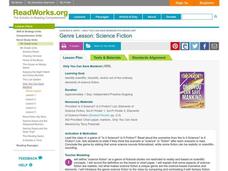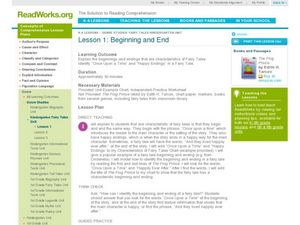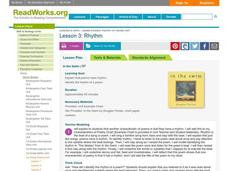Curated OER
Modernism in Poetry, Painting, and Music
Are you teaching Modernism to your class? Connect different areas of artistic expression in the Modernist Era. Learners read T.S. Eliot, view art by Pablo Picasso, and listen to a Modernist musical composition. This final assignment is...
Curated OER
Jabberwocky-Identifying Adjectives
Elementary learners identify adjectives in sentences. They read the poem "Jabberwocky" by Lewis Carroll and highlight the adjectives. A good supplemental lesson if you are studying Lewis Carroll and/or "Jabberwocky."
Curated OER
Drama-Dialogue
Use drama to study and practice dialogue. Creative minds discuss what dialogue tells about a character, and how it can be used to advance the plot. They read a play, think about what they gleaned from dialogue, and record their...
Curated OER
Patricia Polacco Internet Scavenger Hunt
Third graders read each question contained on the worksheet. They click on the underlined website to locate the answer holding down the control button while clicking on the blue words. They then print off their paper and turn them in.
Curated OER
What is a Biography?
Investigate biographies with your class. Compare autobiographies and biographies of Martin Luther King, Jr. as an example. Learners explore the factual components that make up a biography and locate several biographies of notable...
Curated OER
Poetry and Hip Hop
High schoolers compare and contrast the genres of poetry and hip-hop. They view a poetry slam and write about it in their journals. Learners view a Lauryn Hill music video and respond to it in their journals. They compare and contrast...
Curated OER
Computer Book Report
Third graders, after watching a demo by the teacher, fills in his own sample book report card on the computer. They also enter information into a database.
Curated OER
Discovering the Deep
Students explore the world's oceans. They research questions about the oceans and write a research report about an ocean animal. Students identify at least four different writing genres they experienced while reading about the ocean.
Curated OER
Myths, Folktales, & Fairy Tales
Srtudents explore the folktale and folklore genres as well as the world of myths. They read myths and folktales to increase knowledge of world cultures and traditions and follow the writing process to create writing in different genres.
Curated OER
Myths, Folktales & Fairy Tales
Students relate the myth genre to history and culture. In this myths instructional activity, students compare culture in the past and present. Students answer critical thinking questions and discuss the unique characteristics of the...
Curated OER
Duking It Out
Young scholars read and discuss 'Lincoln Center Jazz Orchestra: Mixing Treasures by Duke Ellington and Edvard Grieg,' exploring how jazz transformed European music and the influence jazz has had on modern music. They write musical reviews.
Curated OER
Nature
Discuss what makes a myth with your class as you read two titles that exemplify the genre. Two myths that explain events in nature are read and charted, focusing on details from the text. The lesson culminates in a practice activity...
Curated OER
The Rule of Three
What makes a fairy tale a fairy tale? Teach young readers one characteristic that defines the fairy tale genre. They'll learn that events, objects and characters in fairy tales often occur in threes. They read Goldilocks and the Three...
Curated OER
Science Fiction
Do your sixth graders like science fiction? Learn to identify elements of the science fiction genre with a literature lesson. They read from Only You Can Save Mankind and identify the objects, words, and characters from the scenarios....
Curated OER
Lesson 1: Plot Problems
Add another characteristic to your class characteristics of fairy tales chart. First they discuss the concept of problems or conflicts found in most fairy tale plots then they practice identifying conflict as they read. They read the...
Curated OER
Lesson 2: Important Person
What kid wouldn't love to learn about George Washington? The class reads a simplistic biography about George Washington to find out why he is so famous. They chart the things he did, as well as what makes a non-fiction book a biography....
Curated OER
Lesson 1: Beginning and End
Students study fairy tales. In this fairy tales lesson, students discover beginning and ending phrases characteristic of these types of stories. They listen to their teacher read The Frog Prince, take notice of those familiar phrases,...
Curated OER
Heroes
Students read the story of Paul Bunyan and identify the characteristics and actions that make him a hero. In this heroes lesson plan, students explain their answer and draw pictures.
Curated OER
Humorous Solutions
Discover with your class the humorous solution that follows tall tales. Elementary learners will discuss the tall tale Paul Bunyan and give ordinary solutions for the problems in the story. They will read Sally Ann Thunder Ann Whirlwind...
Curated OER
Exaggeration
Students read the tall tale of Pecos Bill and identify an exaggeration in the story which they state as being part of a tall tale. In this exaggeration lesson plan, students identify the exaggeration by drawing a picture.
Curated OER
Lesson 2: Chronological Order
Examining life events is a great way to learn about chronological order. Sequencing and time order are analyzed after reading a book about Rosa Parks. With a chart, the class works together to put the events from Mrs. Parks' life in the...
Curated OER
Significant Contribution
Examine the lives of people who have made a significant contribution to society. The concept of biography is discussed with the class; they identify important actions, and read passages about Sacagawea and Benjamin Franklin. They write...
Curated OER
Explanatory Myths Lesson
A myth is a story that explains something in nature or society. Dive into the study of mythology as you read The Golden Flower with your class. Charts are used to define the characteristics of myths as well as to determine the main point...
Curated OER
Rhythm
One of the most fun characteristics of a poem is rhythm! Little ones will clap along as you read a poem, to determine the rhythm of the piece. The book In the Swim is used throughout the lesson; it contains fish themed poems that kids...
Other popular searches
- Reading Genres
- List of Reading Genres
- Different Reading Genres
- Reading Genres Bingo
- 3rd Grade Reading Genres
- Reading Genres Lesson Plans
- Reading Genres Labels
- Teaching Reading Genres
- Reading Genres Rainbow
- Reading Genres of Fiction
- Comparing Genres in Reading
- Reading Mystery Genres

























